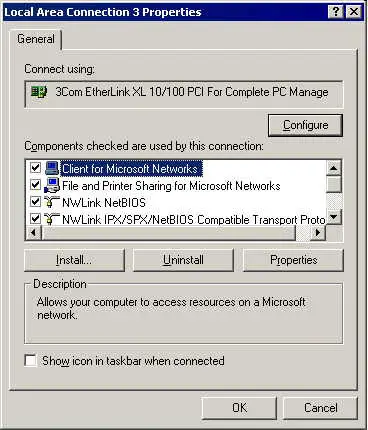In the annals of Windows networking history, “Client for Microsoft Networks” stands as a pivotal component, instrumental in shaping the early landscape of networked computing. Originating in the era of Windows 95 and evolving through subsequent versions like Windows NT, 98, and 2000, this feature was the cornerstone of network connectivity in Microsoft environments.
In this article, we delve into the origins and evolution of the Client for Microsoft Networks, exploring how it enabled file and print services across Windows networks and adapted to the changing technological landscape. We also dissect its functionality, examining its compatibility with various networking protocols and its role across different Windows versions. This journey not only highlights a key chapter in the history of Windows networking but also sheds light on the evolutionary path of network technology.

Table of Contents:
- What Was “Client for Microsoft Networks”?
- Origins and Evolution
- How It Worked
- Networking in the Windows Ecosystem
- The Shift to Advanced Networking Technologies
- The Legacy and Discontinuation
- Conclusion
- References
1. What was Client for Microsoft Networks?
Client for Microsoft Networks was a Microsoft Windows 95, Windows 98, and Windows 2000 networking component that made it possible to access file and print services on Windows 95, Windows 98, Windows NT, Windows 2000, Windows for Workgroups, and LAN Manager dedicated servers and peer servers. Client for Microsoft Networks works with any combination of NetBEUI, IPX/SPX-Compatible Protocol, and TCP/IP protocols.
Client for Microsoft Networks cannot be used for accessing non-Microsoft servers such as Novell NetWare servers. You must install Client for NetWare Networks to access these servers.
Windows 95 and Windows 98 allow you to install more than one client at a time to access different kinds of servers on the network.
2. Origins and Evolution
Introduction to the Network Client in Early Windows (Windows 95 and NT)
The Client for Microsoft Networks debuted with Windows 95, a time when networking was becoming integral to computing. This component was vital for Windows-based computers to connect to and communicate within a network, particularly in corporate and small business settings. With the introduction of Windows NT, this client became an essential part of a more robust and secure network environment, tailored to the needs of enterprise-level networking.
Facilitating File and Print Services on Windows Networks
The primary function of the Client for Microsoft Networks was to enable access to shared resources like files and printers on a network. In the pre-cloud era, this capability was crucial for collaborative work environments, allowing users to share and access resources seamlessly across a networked Windows landscape.
Evolution of the Client Through Windows 98 and Windows 2000
As Microsoft continued to develop its operating systems, the Client for Microsoft Networks evolved to meet the demands of more advanced and diverse networking scenarios. With Windows 98 and Windows 2000, the client was enhanced to support more complex network structures, offering improved performance and security features that catered to the growing needs of both personal and professional users.

3. How It Worked
Technical Details on How the Client for Microsoft Networks Functioned:
At its core, the Client for Microsoft Networks served as a mediator between a Windows computer and the network it was part of. It managed the interactions required for network communication, handling tasks like network logons, access to shared resources, and the management of network connections.
Compatibility with Protocols like NetBEUI, IPX/SPX, and TCP/IP
This client was designed to be versatile, supporting various networking protocols that were prevalent at the time. NetBEUI, known for its simplicity and efficiency in small networks, IPX/SPX, popular in Novell NetWare environments, and TCP/IP, the backbone of the modern internet, were all compatible with the Client for Microsoft Networks. This wide range of protocol support ensured that Windows computers could operate in diverse network setups.
Distinction Between Its Functionality in Different Windows Versions
Over time, as Windows evolved, so did the capabilities of the Client for Microsoft Networks. Each version of Windows brought refinements and new features to the client. For instance, the integration of the client in Windows 95 was a significant step in making networking more user-friendly for the average consumer, while in Windows NT, it emphasized security and enterprise-level management. In Windows 2000, the focus shifted towards greater scalability and reliability, catering to the expanding internet-driven landscape.
4. Networking in the Windows Ecosystem
Overview of Windows Networking During the 90s and Early 2000s
The 1990s and early 2000s marked a significant era in Windows networking, characterized by rapid development and increasing integration of network capabilities into the Windows operating system. This period saw the transition from standalone computers to networked systems, with Windows playing a pivotal role in the adoption of networking in both personal and business computing. The introduction of Windows 95, followed by Windows NT, 98, and 2000, brought networking to the forefront of the operating system’s features.
During this time, networking was primarily centered around LAN (Local Area Network) environments, with a focus on file and print sharing within office and home settings. Microsoft’s networking strategy revolved around making these features more accessible and user-friendly, catering to a growing base of users who were becoming increasingly reliant on networked resources for daily computing tasks.
The Role of Client for Microsoft Networks in the Broader Context of Windows Networking
The Client for Microsoft Networks was integral to this ecosystem. It enabled Windows computers to join and function within a networked environment. This included participating in workgroup settings, common in home and small office networks, where it facilitated the sharing of files and printers among computers without the need for a centralized server.
In more structured environments, like business networks, the Client for Microsoft Networks allowed computers to join Windows domains. This capability was crucial for centralized management of network resources, user authentication, and policy enforcement. The client ensured seamless integration of individual computers into larger, more complex network structures, paving the way for efficient resource sharing and management in corporate settings.
5. The Shift to Advanced Networking Technologies
Discussion on the Evolution of Networking Technologies in Windows
As networking technology evolved, so did Windows’ approach to networking. The late 90s and early 2000s were a time of significant change, with a focus on enhancing network security, performance, and scalability. Microsoft continually updated its networking stack to keep pace with these advancements, incorporating new standards and protocols to improve functionality and security.
Transition from SMBv1 to More Secure Versions like SMBv2 and SMBv3
A key aspect of this evolution was the transition from the Server Message Block (SMB) version 1 protocol to SMBv2 and later SMBv3. SMBv1, widely used in the era of Windows 95 through Windows 2000, was foundational for file and print sharing but had limitations in terms of security and performance. SMBv2, introduced with Windows Vista and Windows Server 2008, brought significant improvements, including increased security, better performance over wide-area networks, and support for larger buffer sizes.
SMBv3, further refined in subsequent Windows releases, added enhanced security features like encryption and improved the protocol’s overall efficiency and reliability. These advancements were crucial in addressing the increasing demands for secure and high-performance networking in the face of growing cyber threats and the expanding scale of network environments.
Impact of These Changes on the Client for Microsoft Networks
The advancements in SMB and other networking technologies fundamentally changed the networking landscape in Windows. As these technologies became more sophisticated, the role of the Client for Microsoft Networks also evolved. The need for a separate, distinct client for accessing network resources diminished as networking capabilities became more deeply integrated and standardized within the Windows operating system.
This transition reflected a broader shift in Microsoft’s networking strategy, moving from a focus on basic network connectivity to a more comprehensive approach encompassing security, performance, and seamless integration across diverse network environments. The Client for Microsoft Networks, once a standalone component, gradually became part of a larger, more advanced networking framework within Windows.
6. The Legacy and Discontinuation
Exploration of Why and When the Client for Microsoft Networks Was Phased Out
The phase-out of the Client for Microsoft Networks coincided with the evolution of Windows networking technologies and the broader shift in networking paradigms. As Microsoft Windows progressed beyond Windows 2000, the integration of network functionalities became more inherent within the operating system, reducing the need for separate client components like the Client for Microsoft Networks. The exact timing of its discontinuation aligns with these broader changes, as newer versions of Windows introduced more advanced networking capabilities that were deeply embedded within the system.
Its Legacy and Impact on Modern Windows Networking
The legacy of the Client for Microsoft Networks is significant in the context of Windows networking history. It represented a foundational step in bringing network connectivity and resource sharing to a broad user base. Its impact is seen in how modern Windows systems handle network interactions—streamlined, secure, and integrated. The principles of easy access to network resources, user authentication, and network management that were central to the Client for Microsoft Networks have been carried forward and enhanced in modern networking implementations.
Transition to Modern Network Clients and Protocols in Later Windows Versions
In later versions of Windows, the functionalities that were once part of the Client for Microsoft Networks have been absorbed into the operating system. This includes the use of more secure and efficient protocols like SMBv2 and SMBv3, which offer enhanced security and performance. The transition reflects a move towards a more unified and secure networking approach, incorporating features like automatic encryption and improved data handling efficiencies.
7. Conclusion
The Client for Microsoft Networks played a pivotal role in the history of Windows networking, marking a significant era where network connectivity became accessible and integral to the Windows operating system. Its introduction and evolution through the 90s and early 2000s laid the groundwork for the advanced networking features we see in Windows today.
Reflecting on its contribution, we can appreciate how it helped shape the development of network technologies in Windows, transitioning from a standalone component to an integral part of a sophisticated and secure networking framework. The Client for Microsoft Networks, while no longer a distinct feature in modern Windows, leaves a lasting impact on how we approach and implement network connectivity in computing environments.
8. References
- “Windows Internals, Part 1” by Mark Russinovich, David A. Solomon, and Alex Ionescu.
- “TCP/IP Illustrated, Volume 1: The Protocols” by W. Richard Stevens.
- RFC 1001 and RFC 1002 – Protocol Standard for a NetBIOS Service on a TCP/UDP Transport: Concepts and Methods.
- “Networking with Microsoft Windows Vista” by Paul McFedries.
- “Mastering Windows Server 2016” by Brian Svidergol, Vladimir Meloski, Byron Wright, and Santos Martinez.